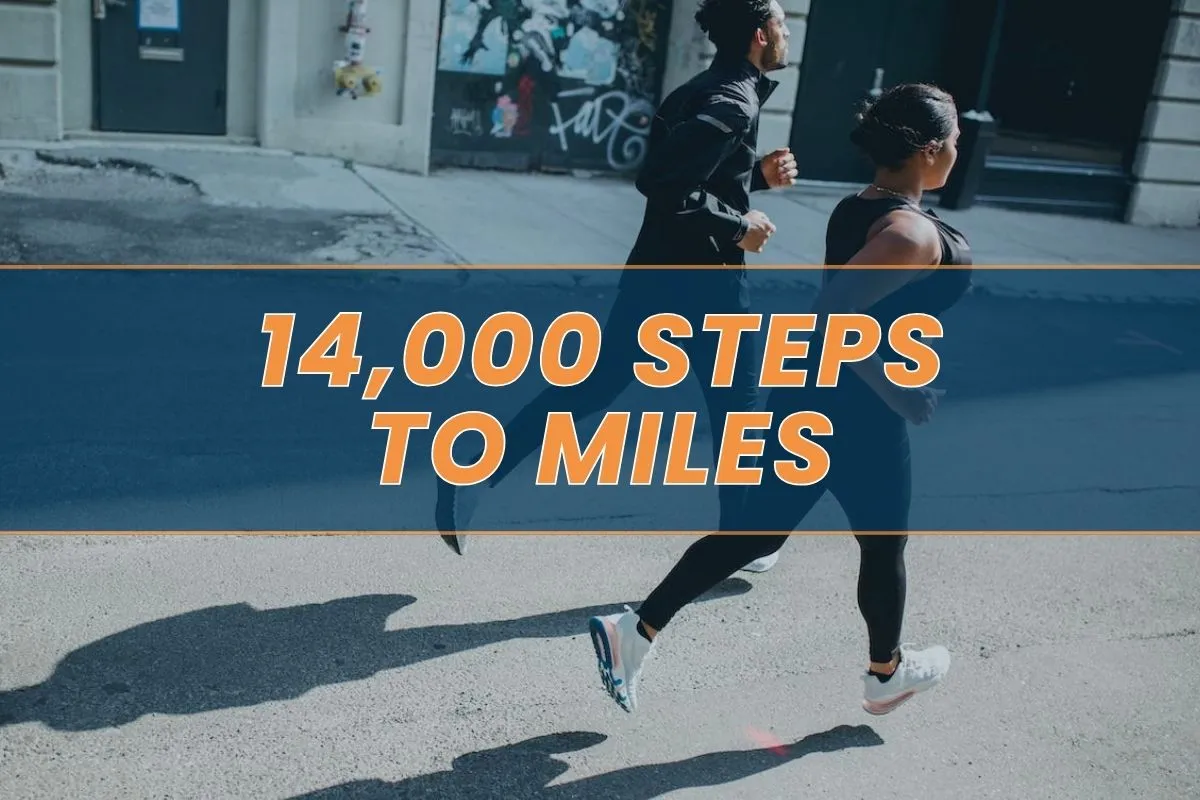Converting 14,000 Steps to Miles: Walking Vs. Running
The idea of converting 14,000 steps to miles can be daunting for many people. If your goal is to measure the distance you run or walk, or to monitor your daily/weekly fitness goals, this article provides you with a lot of helpful information.
Some people may wonder, “14000 steps equals how many miles?” Discover how long it takes to run or walk 14,000 steps and uncover other facts about this distance.
How Many Miles Is 14,000 Steps?
So, how far is 14,000 steps? Converting 14,000 steps to miles depends on factors such as gender, height, and stride length. Walking 14 000 steps is approximately 6.3 miles and would take around 2:30, while 14000 steps of moderate running averages 1:30 and is equal to around 9 miles.

14,000 Steps: How Much and When to Convert?
14,000 steps is roughly equivalent to 6.3 miles or 9.6km when walking at the average pace of 3 mph, although the exact distance depends on several factors, such as gender, height, and stride length.
When it comes to converting 14k steps in miles running or walking, the difference lies in people’s speed and stride length. People with longer strides cover more ground with each step than those with shorter ones do. Here’s a table showing the distance of 14000 steps in miles depending on various factors.
| Activity type | Men miles | Men km | Women miles | Women km |
|---|---|---|---|---|
| Very slow walk (<2 mph) | 4.07 | 6.4 | 3.91 | 6.3 |
| Slow walk (2 mph) | 5 | 8 | 4.75 | 7.6 |
| Average walk (3 mph) | 6.46 | 9.6 | 6.05 | 9.7 |
| Brisk walk (4 mph) | 7.56 | 11.3 | 7.01 | 11.2 |
| Jog (5 mph) | 7.63 | 12.2 | 7.2 | 11.5 |
| Run (6 mph) | 9.04 | 14.5 | 8.45 | 13.5 |
| Fast run (7.5mph) | 11.1 | 17.8 | 10.23 | 16.5 |
| Very fast run (10 mph) | 14.38 | 23.1 | 12.94 | 19.3 |
Distance Calculator: How many miles in 14000 steps
We suggest you use the calculator to determine how many miles are in 14,000 steps depending on your height. The calculator is based on a formula for calculating the distance depending on the average step length and height of the runner.
Distance Calculator
Result:
How Long Does It Take to Run 14,000 Steps?
When running 14 000 steps, the distance you cover depends on several factors, such as age, training level, height, gender, and stride length. Stride length is important to consider when converting steps to miles because it can vary greatly, even among people with similar builds.
| Activity type | Average men time | Average women time |
|---|---|---|
| Jog (5 mph) | 01:32 | 01:26 |
| Run (6 mph) | 01:30 | 01:24 |
| Fast run (7.5 mph) | 01:29 | 01:21 |
| Very fast run (10 mph) | 01:26 | 01:17 |
Fortunately, it is relatively simple to calculate how long it takes to run 14,000 steps using an average running pace and mile time.
The Benefits of Running 14,000 Steps a Day
Running 14000 steps a day can provide tremendous benefits for your body and mind. Running at a steady pace can improve cardiovascular fitness, increase muscular strength and endurance, and reduce the likelihood of various health issues, such as obesity and type 2 diabetes.
Physically active adults who run 14k steps daily also tend to report lower levels of stress than those with low daily activity. Additionally, running helps with weight management, not only by directly burning calories, but also through increased metabolic rate during rest periods.
Finally, regular running has a positive impact on mood due to the endorphin release after exercising, which leads to better quality sleep cycles.
How Long Does It Take to Walk 14,000 Steps?
How much is 14000 steps in minutes? The time it takes to run or walk 14,000 steps can vary greatly, depending on speed and the individual's physical fitness. At a slow pace of 2 mph, one would cover 5 miles in 2.5 hours when taking 14,000, which equates to around 93 steps per minute.
If you walk at a moderate pace of 3 mph, then you would cover around 6.46 miles in 2:10, with an average of 108 steps per minute. Here’s a table showing statistics for other speeds:
| Activity type | Average men time | Average women time |
|---|---|---|
| Very slow walk (<2mph) | 02:42 | 02:36 |
| Slow walk (2mph) | 02:30 | 02:22 |
| Average walk (3 mph) | 02:09 | 02:01 |
| Brisk walk (4 mph) | 01:53 | 01:45 |
It is important to find a suitable speed for each person based on their current level of physical training in order to make comfortable progress without overexertion.
How Many Calories Are Burned in 14,000 Steps?
Both walking and running 14,000 steps every day can be a great way to maintain and reduce weight if combined with a balanced diet. Factors such as age, body size, and speed determine how quickly you will reach your goal for losing weight. If you run fast enough, your body may increase its basal metabolic rate, which helps with burning fat faster.
How Many Calories Are Burned in 14,000 Steps of Running?
Running 14,000 steps a day can be an effective way to improve health and fitness goals, but how many calories are actually burned during the process? Based on an average stride length of 2.5 feet, a bodyweight of 180 pounds, and a running speed of 5mph, you can expect to burn approximately 988 calories from 14,000 steps.
The number of calories burned is influenced by factors such as age, training level, height, and gender, all of which have varying effects on calorie burn rate. If a person weighs 200 pounds and runs with a speed of 6mph, they can expect to burn 1342 calories during a 14,000-step run. A 170-pound runner with an average speed of 7.5mph can burn up to 1380 calories per 14,000 steps.
As you can see, the greater your body weight and the faster you run, the more calories you will burn in 14,000 steps.
How Many Calories Are Burned in 14,000 Steps of Walking?
The total number of calories burned in 14000 steps of walking also depends on factors such as weight, height, and distance walked. Walking 14,000 steps at a speed of 4 mph burns approximately 834 calories for a 200-pound person.
A person who weighs 180 pounds can burn 509 calories walking 14,000 at 2mph speed. It's important to note that more accurate numbers can be established using fitness apps or smart watches, which take into consideration many more factors than just overall pace.
How to Endure a Distance of 14,000 Steps?
To better manage a 14,000-step effort, it is important to allocate enough time and effort. Recommended exercises for diversifying daily or weekly routines can help improve overall fitness levels and aid in achieving the targeted goal.

How to Cover 14,000 in One Day?
For athletes looking to cover the distance of 14,000 steps per day, it is important to set aside enough time for completing the goal. For most people who are able to run or walk at an average pace, this usually equates to about 1-2 hours of running or 2-3 hours of walking each day.
It is important that runners pay careful attention to their stride length, as well as other factors such as age, gender, height, and physical condition, in order to accurately calculate how many steps they will take per mile.

Pro Tip:
Setting achievable goals like gradually increasing speed over time can help keep motivation high and facilitate progress toward achieving the 14,000-step goal.

Pro Tip:
Setting achievable goals like gradually increasing speed over time can help keep motivation high and facilitate progress toward achieving the 14,000-step goal.
Recommendations for Diversifying Daily Exercises
For runners looking for ways to mix up their daily routine, there are several great options for turning 14,000 steps into miles. Incorporating interval training is a fantastic way to shake things up and push yourself farther than before.
How to Cover 14,000 Steps in a Week?
For runners looking to spread their steps out over the week, it can be beneficial to run a mile or two five days per week, leaving two rest days for recovery. This provides time and rest between runs, while still allowing you to achieve the same total mileage by the end of the week, as if you had run all 14,000 steps in one day.

Pro Tip:
For example, you can divide 14,000 steps into 3 running sessions: 2 easy-pace runs covering 4,000 steps each and 1 long run with 6,000 steps.

Pro Tip:
For example, you can divide 14,000 steps into 3 running sessions: 2 easy-pace runs covering 4,000 steps each and 1 long run with 6,000 steps.
It’s recommended that new runners begin with shorter distances at a relaxed pace, then gradually increase their weekly training in order to build up fitness levels.
Subscribe to Our Running Newsletter!
Get free running tips from renowned professional athletes and discounts from top-notch brands.
Recommendations for Diversifying Weekly Exercises
Pursuing a goal of running 14,000 steps or more in one week can help to develop a consistent and healthy exercise routine. Integrating different forms of physical activity and diversifying weekly exercises is key for keeping your motivation strong.
How to Run 14,000 Steps Correctly?
Running long distances is no easy task. It's important to keep in mind that form and pacing are key if you want to reach your goal and avoid unnecessary injuries. Start by increasing the duration of your runs slowly. Even small increases can have a big impact when exploring distances such as 14,000 steps.
To prevent injury, it’s advisable to try different postures while running. Try maintaining an upright posture, with shoulders relaxed and arms bent at 90° angles. Keep your hips steady, and focus on your posture rather than your speed.
How to Walk 14,000 Steps Correctly?
Walking 14,000 steps can seem like an impossible task at first, but with the right tips and tricks, you'll soon become a pro. First off, be sure to set a comfortable walking pace for your journey. It is also important to maintain proper form as you walk, as this helps reduce the risk of injury.
Consider integrating interval training, which involves switching between a slower and faster pace throughout your walk. This allows you to increase your endurance and fitness level, and keeps your walk interesting.
How to Correctly Count How Many Steps out of 14,000 Have Been Covered?
There are many devices that can accurately count the number of steps taken and help runners and walkers track their progress. Step counters such as pedometers, fitness trackers, walking trackers, distance trackers, and activity trackers provide an exact measurement of all the steps covered throughout the day.
They also have a customized setting that takes into account different stride lengths or paces to more accurately calculate distances. Moreover, they monitor other metrics, such as the number of calories burned, making it easier for runners to reach their desired fitness and health goals.

Frequently Asked Questions About 14,000 Steps into Miles
Is 14,000 Steps a Day a Good Distance to Run?
Racking up 14,000 steps a day is an ambitious goal for seasoned runners. It can be a great way to be active and stay healthy if done safely. Running this distance daily comes with both benefits and potential drawbacks that should be considered before you embark on such a challenge.
Which Is Better: 14,000 Steps Running or Walking?
For a sedentary individual looking for improved cardiovascular health and the benefits associated with exercise, both running and walking offer aerobic activity. Running requires more exertion than walking, but burns more calories in less time.
Final Thoughts on 14,000 Steps to Miles
Converting 14,000 steps to miles can be helpful for people who want to monitor their daily activity levels and fitness goals. The exact distance covered depends on your gender, height, and walking or running speed.
This conversion enables you to track the progress of your exercise more accurately. Using devices designed specifically for tracking activity, such as pedometers or smart watches, can help you gain insight into how many actual steps are needed to reach different mileage goals.
Have you ever tried running 14,000 steps? Please share your experience in the comments below.
Also Read:
- How to Convert Women’s to Men’s Shoe Size
- Best Running Shoes For Forefoot Strikers
- How Long Does It Take To Run 7 Miles
- Can You Run After Knee Replacement
- Running on an Empty Stomach
- Best Running Shoes For Sesamoiditis
- Saucony vs. Brooks
- Best Recovery Drink for Runners
References:
- Freya Oswald et al. “A Scoping Review of the Relationship between Running and Mental Health.” International journal of environmental research and public health vol. 17,21 8059. 1 Nov. 2020 https://www.mdpi.com/1660-4601/17/21/8059
- Jonathan P Folland et al. “Running Technique is an Important Component of Running Economy and Performance.” Medicine and science in sports and exercise vol. 49,7 (2017): 1412-1423 https://journals.lww.com/acsm-msse/fulltext/2017/07000/running_technique_is_an_important_component_of.17.aspx
- Muhammed Mustafa Atakan et al. “Evidence-Based Effects of High-Intensity Interval Training on Exercise Capacity and Health: A Review with Historical Perspective.” International journal of environmental research and public health vol. 18,13 7201. 5 Jul. 2021 https://www.ncbi.nlm.nih.gov/pmc/articles/PMC8294064/
- Step to Miles Calculator. https://www.thecalculatorsite.com/health/steps-miles.php (accessed November 1, 2023)
- Taylor Musgjerd et al. “Effect of Increasing Running Cadence on Peak Impact Force in an Outdoor Environment.” International journal of sports physical therapy vol. 16,4 1076-1083. 1 Aug. 2021 https://ijspt.scholasticahq.com/article/25166-effect-of-increasing-running-cadence-on-peak-impact-force-in-an-outdoor-environment
If you have any questions or suggestions, you can contact us via email – [email protected]






